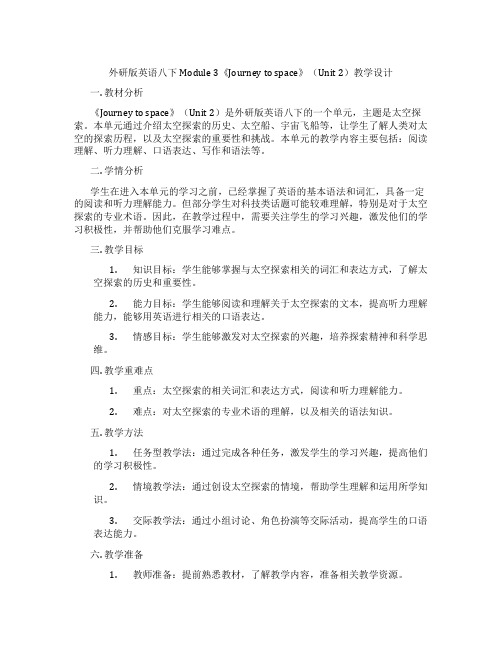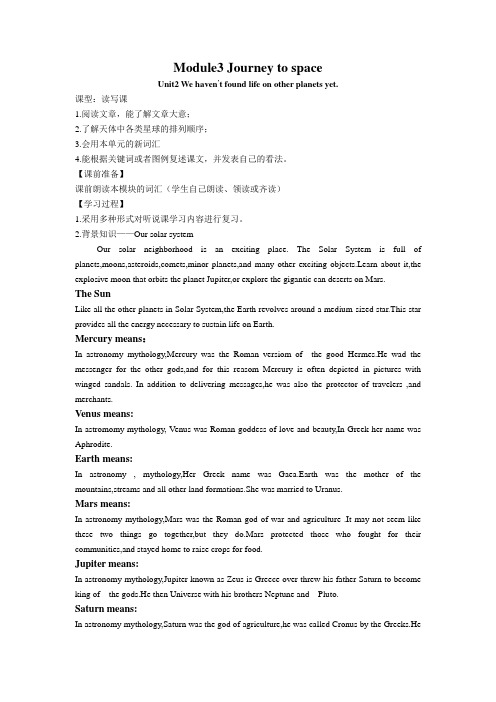八年级英语下册 Module 3 Journey to space阅读拓展课件 (新版)外研版
外研版英语八下Module3《Journeytospace》(Unit3)说课稿

外研版英语八下Module 3《Journey to space》(Unit 3)说课稿一. 教材分析《Journey to space》(Unit 3)是外研版英语八下的一个单元,本节课的主要内容是关于太空探索的知识。
教材通过讲述人类对太空的探索历程,让学生了解太空的基本知识,提高他们对科学探索的热情。
教材内容丰富,插图生动,有利于激发学生的学习兴趣。
二. 学情分析根据我对学生的了解,他们在学习过程中对新鲜事物充满好奇,善于接受新知识。
但同时,他们对英语词汇和语法知识的掌握程度参差不齐。
因此,在教学过程中,我需要关注每一个学生的学习进度,尽量让每个人都有所收获。
三. 说教学目标1.知识目标:让学生掌握太空探索的基本知识,了解人类对太空的探索历程。
2.能力目标:培养学生运用英语描述和讨论太空探索的能力。
3.情感目标:激发学生对科学探索的热情,培养他们积极向上的精神风貌。
四. 说教学重难点1.重点:让学生掌握太空探索的基本知识和相关词汇。
2.难点:引导学生运用英语描述和讨论太空探索的过程,提高他们的语言表达能力。
五. 说教学方法与手段1.情境教学法:通过设定太空探索的情境,让学生在实际语境中学习英语。
2.任务型教学法:引导学生参与各种任务,提高他们的实践能力。
3.多媒体教学手段:运用课件、视频等多媒体资源,丰富教学内容,提高学生的学习兴趣。
六. 说教学过程1.导入:通过展示太空探索的图片,引导学生谈论太空,激发他们的学习兴趣。
2.新课呈现:讲解太空探索的基本知识,让学生了解人类对太空的探索历程。
3.课堂实践:学生进行小组讨论,让他们运用英语描述和讨论太空探索的过程。
4.巩固练习:通过完成相关练习题,检查学生对知识的掌握程度。
5.课堂小结:总结本节课的主要内容,提醒学生课后进行复习。
七. 说板书设计板书设计要简洁明了,突出本节课的主要内容。
可以设计成思维导图的形式,将太空探索的基本知识和人类探索历程呈现出来。
外研版英语八下Module 3《Journey to space》教学设计

外研版英语八下Module 3《Journey to space》教学设计一. 教材分析《Journey to space》是外研版英语八下Module 3的一篇课文,主要介绍了人类对太空的探索历程以及未来太空旅行的可能性。
课文内容丰富,语言难度适中,符合新课程标准的要求。
通过学习本模块,学生可以了解太空探索的历史和现状,提高英语语言能力,拓展视野。
二. 学情分析学生在学习本模块之前,已经掌握了基本的英语语法和词汇,具备一定的听力、口语、阅读和写作能力。
但部分学生在英语学习上存在恐惧心理,缺乏自信心,尤其对听力理解和口语表达有一定的抵触情绪。
此外,学生对本模块话题的熟悉程度不同,对太空探索的了解也各有差异。
三. 教学目标1.知识目标:学生能掌握课文中的关键词汇和句型,了解人类太空探索的历史和现状。
2.能力目标:学生能熟练运用所学词汇和句型进行听力、口语、阅读和写作练习。
3.情感目标:激发学生对太空探索的兴趣,培养他们积极向上的探索精神。
四. 教学重难点1.重点:课文的理解和词汇的掌握。
2.难点:听力理解、口语表达以及阅读写作能力的提高。
五. 教学方法1.任务型教学法:通过完成各种任务,激发学生的学习兴趣,提高他们的参与度。
2.情境教学法:创设真实的太空探索情境,帮助学生更好地理解课文内容。
3.交际式教学法:鼓励学生积极参与课堂讨论,提高口语表达能力。
六. 教学准备1.教师准备:提前熟悉课文内容,了解太空探索的相关知识,准备教学素材。
2.学生准备:预习课文,查阅相关资料,了解太空探索的基本知识。
七. 教学过程1.导入(5分钟)教师通过提问方式引导学生回顾太空探索的相关知识,激发学生的学习兴趣。
2.呈现(10分钟)教师播放课文音频,让学生跟随音频朗读课文,注意语音语调的准确性。
3.操练(15分钟)教师设计听力练习,让学生听懂并回答问题。
然后分组进行角色扮演,模拟太空探索的场景,提高口语表达能力。
4.巩固(10分钟)教师学生进行小组讨论,总结课文中的关键词汇和句型,并完成相关练习。
外研版英语八下Module 3《Journey to space》(Unit 3)教学设计

外研版英语八下Module 3《Journey to space》(Unit 3)教学设计一. 教材分析《Journey to space》是外研版英语八年级下册Module 3的一篇课文,主要介绍了太空探索的历史、现状和未来。
本文通过讲述人类对太空的探索过程,使学生了解太空知识,激发他们对科学的热爱和好奇心。
课文内容丰富,语言简练,插图生动,适合学生学习。
二. 学情分析八年级的学生已经具备了一定的英语基础,对太空有一定的了解。
但他们在阅读长篇文章时,可能会遇到生词和复杂句子结构的障碍。
因此,在教学过程中,教师需要帮助学生克服这些困难,提高他们的阅读理解能力。
三. 教学目标1.知识目标:学生能够掌握课文中的生词和短语,理解课文大意,了解太空探索的历史、现状和未来。
2.能力目标:学生能够运用所学知识,进行口语交流和写作表达。
3.情感目标:培养学生对科学的热爱和好奇心,提高他们的综合素质。
四. 教学重难点1.重点:课文内容的掌握,生词和短语的学习。
2.难点:复杂句子结构的理解,口语表达和写作能力的提高。
五. 教学方法1.任务型教学法:通过完成各种任务,让学生在实践中学习英语。
2.情境教学法:创设生动的情境,激发学生的学习兴趣。
3.合作学习法:鼓励学生分组讨论,培养团队协作能力。
六. 教学准备1.课文录音:为学生提供听力材料,提高他们的听力能力。
2.教学课件:制作课件,辅助教学,使课堂更加生动有趣。
3.相关资料:收集与太空探索相关的资料,用于拓展学生的知识面。
七. 教学过程1.导入(5分钟)教师播放太空探索的短视频,引导学生谈论对太空的了解和兴趣,为新课的学习营造氛围。
2.呈现(10分钟)教师展示课文图片,引导学生观察并猜测课文内容。
然后逐段呈现课文,让学生跟读并模仿语音语调。
3.操练(10分钟)教师设计各种任务,如填空、选择、问答等,让学生分组完成,巩固课文内容。
4.巩固(5分钟)教师学生进行角色扮演,模拟太空探索的场景,提高他们的口语表达能力。
2017-2018学年外研版八年级英语下册Module3Journeytospace教案

一、教学内容
本节课选自2017-2018学年外研版八年级英语下册Module 3 Journey to space。教学内容主要包括以下章节:
1. Unit 1: Has it arrived yet?
-学习询问和描述物体位置的句型。
-实际情境对话:学生在实际对话中可能难以将所学语法和词汇灵活运用。
-难点举例:在小组讨论中,学生可能不知道如何使用合适的时态和词汇来讨论一个假想的太空旅行。
四、教学流程
(一)导入新课(用时5分钟)
同学们,今天我们将要学习的是《Journey to Space》这一章节。在开始之前,我想先问大家一个问题:“你们是否想象过成为宇航员,探索未知的宇宙?”这个问题与我们将要学习的内容密切相关。通过这个问题,我希望能够引起大家的兴趣和好奇心,让我们一同探索太空的奥秘。
其次,在新课讲授环节,我发现有些同学在理解一般过去时、现在完成时和一般将来时方面存在一定的困难。针对这个问题,我在课堂上通过举例和对比进行了详细的解释,希望同学们能够更好地掌握这些语法知识点。在今后的教学中,我还需要多关注这部分学生的掌握情况,加强个别辅导。
此外,实践活动中的分组讨论和实验操作,让同学们将所学知识应用到实际情境中,提高了他们的动手能力和团队协作能力。从成果展示来看,大部分同学能够运用所学词汇和语法进行讨论和表达,达到了教学目标。
4. Unit 4: A comet is coming to visit the Earth.
-学习描述天体和天文现象的词汇。
-运用一般将来时描述即将发生的事件。
二、核心素养目标
本章节的核心素养目标主要包括:
外研版英语八下Module3《Journeytospace》(Unit2)教学设计

外研版英语八下Module 3《Journey to space》(Unit 2)教学设计一. 教材分析《Journey to space》(Unit 2)是外研版英语八下的一个单元,主题是太空探索。
本单元通过介绍太空探索的历史、太空船、宇宙飞船等,让学生了解人类对太空的探索历程,以及太空探索的重要性和挑战。
本单元的教学内容主要包括:阅读理解、听力理解、口语表达、写作和语法等。
二. 学情分析学生在进入本单元的学习之前,已经掌握了英语的基本语法和词汇,具备一定的阅读和听力理解能力。
但部分学生对科技类话题可能较难理解,特别是对于太空探索的专业术语。
因此,在教学过程中,需要关注学生的学习兴趣,激发他们的学习积极性,并帮助他们克服学习难点。
三. 教学目标1.知识目标:学生能够掌握与太空探索相关的词汇和表达方式,了解太空探索的历史和重要性。
2.能力目标:学生能够阅读和理解关于太空探索的文本,提高听力理解能力,能够用英语进行相关的口语表达。
3.情感目标:学生能够激发对太空探索的兴趣,培养探索精神和科学思维。
四. 教学重难点1.重点:太空探索的相关词汇和表达方式,阅读和听力理解能力。
2.难点:对太空探索的专业术语的理解,以及相关的语法知识。
五. 教学方法1.任务型教学法:通过完成各种任务,激发学生的学习兴趣,提高他们的学习积极性。
2.情境教学法:通过创设太空探索的情境,帮助学生理解和运用所学知识。
3.交际教学法:通过小组讨论、角色扮演等交际活动,提高学生的口语表达能力。
六. 教学准备1.教师准备:提前熟悉教材,了解教学内容,准备相关教学资源。
2.学生准备:预习教材,了解太空探索的基本知识。
七. 教学过程1.导入(5分钟)教师通过展示太空探索的图片或视频,引导学生谈论太空探索的话题,激发学生的学习兴趣。
2.呈现(10分钟)教师通过展示教材中的阅读文本,让学生初步了解太空探索的历史和重要性。
同时,教师引导学生关注文章中的关键词汇和表达方式。
外研版英语八下Module3《Journeytospace》(Unit2)说课稿

外研版英语八下Module 3《Journey to space》(Unit 2)说课稿一. 教材分析《Journey to space》(Unit 2)是外研版英语八下的一个单元,本单元的主题是关于太空探索。
通过本单元的学习,学生可以了解人类对太空的探索历程,掌握相关的词汇和语法知识,提高英语听说读写的能力。
本单元的主要内容包括:阅读一篇关于太空探索的短文,听一个关于太空探索的听力材料,以及完成一个关于太空探索的写作任务。
二. 学情分析在进入本单元的学习之前,学生已经学习了一些与科技相关的英语知识,对太空探索有一定的了解。
然而,由于太空探索是一个复杂而深奥的领域,学生可能需要更多的帮助来理解相关的概念和术语。
此外,由于本单元的学习内容较为复杂,学生可能需要更多的练习来巩固所学的知识。
三. 说教学目标本单元的教学目标包括:1.学生能够理解并运用与太空探索相关的词汇和短语。
2.学生能够理解并运用与太空探索相关的语法知识。
3.学生能够听懂并理解与太空探索相关的听力材料。
4.学生能够阅读并理解与太空探索相关的短文。
5.学生能够完成与太空探索相关的写作任务。
四. 说教学重难点本单元的教学重难点包括:1.与太空探索相关的词汇和短语的理解和运用。
2.与太空探索相关的语法知识的理解和运用。
3.听懂并理解与太空探索相关的听力材料。
4.阅读并理解与太空探索相关的短文。
5.完成与太空探索相关的写作任务。
五. 说教学方法与手段在本单元的教学中,我将采用以下教学方法与手段:1.任务型教学法:通过完成各种任务,激发学生的学习兴趣,提高学生的学习积极性。
2.情境教学法:通过创设各种情境,帮助学生理解和学习与太空探索相关的知识。
3.视听教学法:通过播放与太空探索相关的视听材料,帮助学生更好地理解和学习与太空探索相关的知识。
4.小组合作学习:通过小组合作学习,培养学生的合作能力和团队精神。
六. 说教学过程本单元的教学过程包括以下几个环节:1.导入:通过播放一段与太空探索相关的视听材料,激发学生的学习兴趣,引入本单元的学习内容。
年八年级英语下册Module3Journeytospace同步课件新外研

Unit 1 Unit 2 Unit 3
Unit 2 We have not found life on any other planets yet.
think that there has been life on the earth for hundreds of millions of years.(教材P20)科学家们认为地球上的生命已有数亿 年的历史。
Unit 1 Unit 2 Unit 3
of scientists are working hard in order to send astronauts to Mars one day.(教材P18)为了有一天把宇航员送到火星上去,许多 科学家正在努力。
[解读] in order to意为“为了”。其后跟动词原形,引导目的状语, 置于句首或句中。
[解读1] there has been是there be句型的现在完成时态。there be 句型的时态是通过变化be动词来实现。
There will be rain in all parts of the country next week. 下周全国各地将有雨。 There’s going to be a meeting tomorrow. 明天将要有一个会议。 There is some milk in the bottle. 瓶子里有一些牛奶。
Unit 1 Unit 2 Unit 3
拓展latest用作late的最高级,意为“最晚;最迟”。
Unit 1 Unit 2 Unit 3
[解读2] news不可数名词,意为“新闻;消息”。 No news is good news. 没有消息就是好消息。 注意“一条新闻”可表达为a piece of news。
Module3 Journey to space读写课

Module3 Journey to spaceUnit2 We haven’t found life on other planets yet.课型:读写课1.阅读文章,能了解文章大意;2.了解天体中各类星球的排列顺序;3.会用本单元的新词汇4.能根据关键词或者图例复述课文,并发表自己的看法。
【课前准备】课前朗读本模块的词汇(学生自己朗读、领读或齐读)【学习过程】1.采用多种形式对听说课学习内容进行复习。
2.背景知识——Our solar systemOur solar neighborhood is an exciting place. The Solar System is full of planets,moons,asteroids,comets,minor planets,and many other exciting objects.Learn about it,the explosive moon that orbits the planet Jupiter,or explore the gigantic can deserts on Mars.The SunLike all the other planets in Solar System,the Earth revolves around a medium-sized star.This star provides all the energy necessary to sustain life on Earth.Mercury means:In astronomy mythology,Mercury was the Roman versiom of the good Hermes.He wad the messenger for the other gods,and for this reasom Mercury is often depicted in pictures with winged sandals. In addition to delivering messages,he was also the protector of travelers ,and merchants.Venus means:In astromomy mythology, Venus was Roman goddess of love and beauty,In Greek her name was Aphrodite.Earth means:In astronomy , mythology,Her Greek name was Gaea.Earth was the mother of the mountains,streams and all other land formations.She was married to Uranus.Mars means:In astronomy mythology,Mars was the Roman god of war and agriculture .It may not seem like these two things go together,but they do.Mars protected those who fought for their communities,and stayed home to raise crops for food.Jupiter means:In astronomy mythology,Jupiter known as Zeus is Greece over threw his father Saturn to become king of the gods.He then Universe with his brothers Neptune and Pluto.Saturn means:In astronomy mythology,Saturn was the god of agriculture,he was called Cronus by the Greeks.Heis the son of Uranus,and father of Jupiter.Saturn over threw his father to become king of the gods ,but was then over thrown himselfby his son Jupiter.Uranus means:In astronomy mythology,Uranus was the lord lf the skies and husband of Earth.He was also the king of the gods until his son Saturn overthrew him.Neptune means:In astronomy mythology, Neptune was originally only the god of water,but was later extended to the ocean when he became associated with the Greek god Poseidon.3.多层阅读。
八年级英语下册 Module 3 Journey to space教案

4. Read the conversation.
5. Act it out.
6. Learn“Everyday English”
1) What are you up to?
1. Function: Talking about recent events.
2. Structure: Present perfect with already, just and yet.
3. Skills:
1) Listening for specific information.
2) Talking about space travel; participating in a role-play.
1. Key vocabulary: earth, moon, news, planet, reach, yet, just, model, spaceship, project, no problem, latest, on, discover, astronaut, space travel
2. Key structures: Present perfect with already, just and yet.
10. —Have we sent a spaceship to Mars?
—Yes, we have. But…
11. The spaceship has gone to Mars.
12.However,we havenot found life on other plants yet.
英语八下Module3 Journey to Space辅导教案

10. communicate [联系;交流]v.
communicate是不及物动词,跟宾语时,要加介词with。communicate with sb意为“与某人交流”
【例句】He had no way to communicate with his brother.
他没办法和他的弟弟交流。
但形容词或副词必须放在enough之前,enough之后加动词不定式(to do sth.),意为“足
够……可以做某事”。
【拓展】so +形容词/副词+that从句[如此……以至于……]
too+形容词/副词+to do sth.[意为“太……而不能做某事]
以上两个句型可以与not…enough to do sth.互换。
为了句型舞会,他们把大厅里所有的椅子全推到了一边。
【拓展】in order that后接句子,引导目的状语从句,意为“以便,为了”。
In order that I could hear clearly, he spoke loudly again.
为了让我我听清楚,他又大声地说了一遍。
9. none [没有一个]
e.g.Have you heard the latest news?
你听说过这个最新消息吗?
5.discover [发现;找到]v.
discover是及物动词,表示“发现,了解到”,指发现或找到某种自然界本来已经存在,但是以前未被人类发现或认识的事物,如发现元素、电、煤、石油以及星系或科学真理等。
宇航员已经去过月球了。
She has arrived in Nanjing already.
她已经到达南京。
八年级下册英语第2课时 Module 3 Journey to space

4
Look and say
5
Look and say
嫦娥三号 嫦娥二号
6
Learning to learn
When you read a passage with a title and pictures, think about the words you may find in the passage, and the questions you may want to ask before you start to read.
Why
9
Read the second and third paragraphs, look at some pictures and retell two paragraphs.
10
Scientists ______________(send) spaceships to the planet have sent Mars to take photos. They ______________ have even sent (even, send) spaceships to travel outside the solar system. However, no spaceship ______________ has travelled (travel) far enough to reach other stars in our Galaxy. Scientists have ______________ always asked(always, ask) the questions: with so many stars in the universe, are we alone, or is there life out there in space? ______________(have) there been Have visitors to the earth from other planets? Why has no one communicated with us? We do not know the answers… yet.
八年级英语下册Module3JourneytospaceUnits2_3早读课件

4. possible adj. (事情)可能的 反义词 impossible adj. (事情)办不到的,不可能的 5. communicate v. 联系;交流 communication n.
联系;交流
重点短语
1. on the earth 2. hundreds of millions of
2. 没有一颗行星拥有像地球那样的环境,所以科学家 们认为他们不会在它们上面发现生命。 None of them has an environment like that of the earth, so scientists do not think they will find life on them. (none of…;否定前移)
11. out 12. communicate
n. 群;组 n. 星系 n. 宇宙 n. 光;光线;光亮 adj. (事情)办不到的, 不可能的 adv. 在远方 v. 联系;交流
词形变换
1. environment n. 环境 environmental adj. 环境的 2. that pron. 那,那个 对应词 this pron. 这,这个 3. galaxy n. 星系 复数 galaxies
Module 3 Journey to space Units 2~3
外研·八年级下册
单词串烧
Galaxy is a large group of stars and planets. Compared with the solar system, many other galaxies in the universe are very far away. And their light has to travel for many years to reach us. So it seems impossible to imagine how large the universe is. Though the universe is so large and there are so many planets, scientists haven’t discovered another planet for humans to live on yet. None of the planets has an environment like that of the earth out there in space. In that case(这样看来), the earth is the only place for humans to live on. It’s so important to protect the earth.
